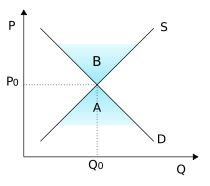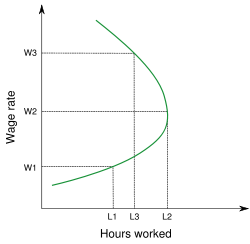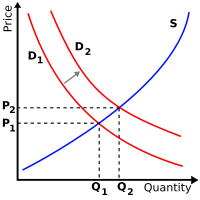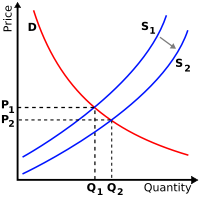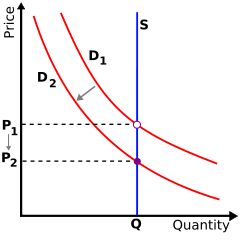Supply and demand
2008/9 Schools Wikipedia Selection. Related subjects: Economics
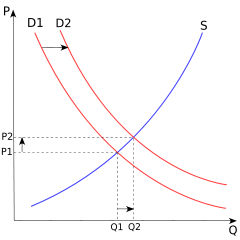
In economics, supply and demand describes market relations between prospective sellers and buyers of a good. The supply and demand model determines price and quantity sold in a market. This model is fundamental in microeconomic analysis, and is used as a foundation for other economic models and theories. It predicts that in a competitive market, price will function to equalize the quantity demanded by consumers, and the quantity supplied by producers, resulting in an economic equilibrium of price and quantity. The model incorporates other factors changing equilibrium as a shift of demand and/or supply.
The fundamentals
Strictly speaking, the model of supply and demand applies to a type of market called perfect competition in which no single buyer or seller has much effect on prices, and prices are known. The quantity of a product supplied by the producer and the quantity demanded by the consumer are dependent on the market price of the product. The law of supply states that quantity supplied is related to price. It is often depicted as directly proportional to price: the higher the price of the product, the more the producer will supply, ceteris paribus ("all other things being equal"). The law of demand is normally depicted as an inverse relation of quantity demanded and price: the higher the price of the product, the less the consumer will demand, ceteris paribus. The respective relations are called the supply curve and demand curve, or supply and demand for short.
The laws of supply and demand state that the equilibrium market price and quantity of a commodity is at the intersection of consumer demand and producer supply. At this point, quantity supplied equals quantity demanded (as shown in the figure ). If the price for a good is below equilibrium, consumers demand more of the good than producers are prepared to supply. This defines a shortage of the good. A shortage results in producers increasing the price until equilibrium is reached. If the price of a good is above equilibrium, there is a surplus of the good. Producers are motivated to eliminate the surplus by lowering the price, until equilibrium is reached.
Supply schedule
The supply schedule, graphically represented by the supply curve, is the relationship between market price and amount of goods produced. In short-run analysis, where some input variables are fixed, a positive slope can reflect the law of diminishing marginal returns, which states that beyond some level of output, additional units of output require larger amounts of input. In the long-run, where no input variables are fixed, a positively-sloped supply curve can reflect diseconomies of scale.
For a given firm in a perfectly competitive industry, if it is more profitable to produce then to not produce, profit is maximized by producing just enough so that the producer's marginal cost is equal to the market price of the good.
Occasionally, supply curves bend backwards. A well known example is the backward bending supply curve of labour. Generally, as a worker's wage increases, he is willing to work longer hours, since the higher wages increase the marginal utility of working, and the opportunity cost of not working. But when the wage reaches an extremely high amount, the employee may experience the law of diminishing marginal utility. The large amount of money he is making will make further money of little value to him. Thus, he will work less and less as the wage increases, choosing instead to spend his time in leisure. The backwards-bending supply curve has also been observed in non-labor markets, including the market for oil: after the skyrocketing price of oil caused by the 1973 oil crisis, many oil-exporting countries decreased their production of oil.
The supply curve for public utility production companies is unusual. A large portion of their total costs are in the form of fixed costs. The supply curve for these firms is often constant (shown as a horizontal line).
Another postulated variant of a supply curve is that for child labor. Supply will increase as wages increase, but at a certain point a child's parents will pull the child from the child labor force due to cultural pressures and a desire to concentrate on education. The supply will not increase as the wage increases, up to a point where the wage is high enough to offset these concerns. For a normal demand curve, this can result in two stable equilibrium points - a high wage and a low wage equilibrium point.
Demand schedule
The demand schedule, depicted graphically as the demand curve, represents the amount of goods that buyers are willing and able to purchase at various prices, assuming all other non-price factors remain the same. The demand curve is almost always represented as downwards-sloping, meaning that as price decreases, consumers will buy more of the good.
Just as the supply curves reflect marginal cost curves, demand curves can be described as marginal utility curves.
The main determinants of individual demand are: the price of the good, level of income, personal tastes, the population (number of people), the government policies, the price of substitute goods, and the price of complementary goods.
The shape of the aggregate demand curve can be convex or concave, possibly depending on income distribution.
As described above, the demand curve is generally downward sloping. There may be rare examples of goods that have upward sloping demand curves. Two different hypothetical types of goods with upward-sloping demand curves are a Giffen good (a sweet inferior, but staple, good) and a Veblen good (a good made more fashionable by a higher price).
Changes in market equilibrium
Practical uses of supply and demand analysis often centre on the different variables that change equilibrium price and quantity, represented as shifts in the respective curves. Comparative statics of such a shift traces the effects from the initial equilibrium to the new equilibrium.
Demand curve shifts
When consumers increase the quantity demanded at a given price, it is referred to as an increase in demand. Increased demand can be represented on the graph as the curve being shifted outward. At each price point, a greater quantity is demanded, as from the initial curve D1 to the new curve D2. More people wanting coffee is an example. In the diagram, this raises the equilibrium price from P1 to the higher P2. This raises the equilibrium quantity from Q1 to the higher Q2. A movement along the curve is described as a "change in the quantity demanded" to distinguish it from a "change in demand," that is, a shift of the curve. In the example above, there has been an increase in demand which has caused an increase in (equilibrium) quantity. The increase in demand could also come from changing tastes, incomes, product information, fashions, and so forth.
If the demand decreases, then the opposite happens: an inward shift of the curve. If the demand starts at D2, and decreases to D1, the price will decrease, and the quantity will decrease. This is an effect of demand changing. The quantity supplied at each price is the same as before the demand shift (at both Q1 and Q2). The equilibrium quantity, price and demand are different. At each point, a greater amount is demanded (when there is a shift from D1 to D2).
Supply curve shifts
When the suppliers' costs change for a given output, the supply curve shifts in the same direction. For example, assume that someone invents a better way of growing wheat so that the cost of wheat that can be grown for a given quantity will decrease. Otherwise stated, producers will be willing to supply more wheat at every price and this shifts the supply curve S1 outward, to S2—an increase in supply. This increase in supply causes the equilibrium price to decrease from P1 to P2. The equilibrium quantity increases from Q1 to Q2 as the quantity demanded increases at the new lower prices. In a supply curve shift, the price and the quantity move in opposite directions.
If the quantity supplied decreases at a given price, the opposite happens. If the supply curve starts at S2, and shifts inward to S1, the equilibrium price will increase, and the quantity will decrease. This is an effect of supply changing. The quantity demanded at each price is the same as before the supply shift (at both Q1 and Q2). The equilibrium quantity, price and supply changed.
When there is a change in supply or demand, there are four possible movements. The demand curve can move inward or outward. The supply curve can also move inward or outward.
See also: Induced demand
Elasticity
A very important concept in understanding supply and demand theory is elasticity. In this context, it refers to how supply and demand respond to various factors. One way to define elasticity is the percentage change in one variable divided by the percentage change in another variable (known as arc elasticity, which calculates the elasticity over a range of values, in contrast with point elasticity, which uses differential calculus to determine the elasticity at a specific point). It is a measure of relative changes.
Often, it is useful to know how the quantity demanded or supplied will change when the price changes. This is known as the price elasticity of demand and the price elasticity of supply. If a monopolist decides to increase the price of their product, how will this affect their sales revenue? Will the increased unit price offset the likely decrease in sales volume? If a government imposes a tax on a good, thereby increasing the effective price, how will this affect the quantity demanded?
Another distinguishing feature of elasticity is that it is more than just the slope of the function. For example, a line with a constant slope will have different elasticity at various points. Therefore, the measure of elasticity is independent of arbitrary units (such as gallons vs. quarts, say for the response of quantity demanded of milk to a change in price), whereas the measure of slope only is not.
One way of calculating elasticity is the percentage change in quantity over the associated percentage change in price. For example, if the price moves from $1.00 to $1.05, and the quantity supplied goes from 100 pens to 102 pens, the slope is 2/0.05 or 40 pens per dollar. Since the elasticity depends on the percentages, the quantity of pens increased by 2%, and the price increased by 5%, so the price elasticity of supply is 2/5 or 0.4.
Since the changes are in percentages, changing the unit of measurement or the currency will not affect the elasticity. If the quantity demanded or supplied changes a lot when the price changes a little, it is said to be elastic. If the quantity changes little when the prices changes a lot, it is said to be inelastic. An example of perfectly inelastic supply, or zero elasticity, is represented as a vertical supply curve. (See that section below)
Elasticity in relation to variables other than price can also be considered. One of the most common to consider is income. How would the demand for a good change if income increased or decreased? This is known as the income elasticity of demand. For example, how much would the demand for a luxury car increase if average income increased by 10%? If it is positive, this increase in demand would be represented on a graph by a positive shift in the demand curve. At all price levels, more luxury cars would be demanded.
Another elasticity sometimes considered is the cross elasticity of demand, which measures the responsiveness of the quantity demanded of a good to a change in the price of another good. This is often considered when looking at the relative changes in demand when studying complement and substitute goods. Complement goods are goods that are typically utilized together, where if one is consumed, usually the other is also. Substitute goods are those where one can be substituted for the other, and if the price of one good rises, one may purchase less of it and instead purchase its substitute.
Cross elasticity of demand is measured as the percentage change in demand for the first good that occurs in response to a percentage change in price of the second good. For an example with a complement good, if, in response to a 10% increase in the price of fuel, the quantity of new cars demanded decreased by 20%, the cross elasticity of demand would be -2.0.
Vertical supply curve (Perfectly Inelastic Supply)
It is sometimes the case that a supply curve is vertical: that is the quantity supplied is fixed, no matter what the market price. For example, the surface area or land of the world is fixed. No matter how much someone would be willing to pay for an additional piece, the extra cannot be created. Also, even if no one wanted all the land, it still would exist. Land therefore has a vertical supply curve, giving it zero elasticity (i.e., no matter how large the change in price, the quantity supplied will not change).
Supply-side economics argues that the aggregate supply function – the total supply function of the entire economy of a country – is relatively vertical. Thus, supply-siders argue against government stimulation of demand, which would only lead to inflation with a vertical supply curve.
Other markets
The model of supply and demand also applies to various specialty markets.
The model applies to wages, which are determined by the market for labor. The typical roles of supplier and consumer are reversed. The suppliers are individuals, who try to sell their labor for the highest price. The consumers of labors are businesses, which try to buy the type of labor they need at the lowest price. The equilibrium price for a certain type of labor is the wage.
The model applies to interest rates, which are determined by the money market. In the short term, the money supply is a vertical supply curve, which the central bank of a country can control through monetary policy. The demand for money intersects with the money supply to determine the interest rate.
Other market forms
The supply and demand model is used to explain the behaviour of perfectly competitive markets, but its usefulness as a standard of performance extends to other types of markets. In such markets, there may be no supply curve, such as above, except by analogy. Rather, the supplier or suppliers are modeled as interacting with demand to determine price and quantity. In particular, the decisions of the buyers and sellers are interdependent in a way different from a perfectly competitive market.
A monopoly is the case of a single supplier that can adjust the supply or price of a good at will. The profit-maximizing monopolist is modeled as adjusting the price so that its profit is maximized given the amount that is demanded at that price. This price will be higher than in a competitive market. A similar analysis can be applied when a good has a single buyer, a monopsony, but many sellers. Oligopoly is a market with so few suppliers that they must take account of their actions on the market price or each other. Game theory may be used to analyze such a market.
The supply curve does not have to be linear. However, if the supply is from a profit-maximizing firm, it can be proven that curves-downward sloping supply curves (i.e., a price decrease increasing the quantity supplied) are inconsistent with perfect competition in equilibrium. Then supply curves from profit-maximizing firms can be vertical, horizontal or upward sloping.
Positively-sloped demand curves?
Standard microeconomic assumptions cannot be used to disprove the existence of upward-sloping demand curves. However, despite years of searching, no generally agreed upon example of a good that has an upward-sloping demand curve (also known as a Giffen good) has been found. Some suggest that luxury cosmetics can be classified as a Giffen good. As the price of a high end luxury cosmetic drops, consumers see it as an low quality good compared to its peers. The price drop may indicate lower quality ingredients, thus consumers would not want to apply such an inferior product to their face.
Lay economists sometimes believe that certain common goods have an upward-sloping curve. For example, people will sometimes buy a prestige good (eg. a luxury car) because it is expensive, a drop in price may actually reduce demand. However, in this case, the good purchased is actually prestige, and not the car itself. So, when the price of the luxury car decreases, it is actually decreasing the amount of prestige associated with the good (see also Veblen good). However, even with downward-sloping demand curves, it is possible that an increase in income may lead to a decrease in demand for a particular good, probably due to the existence of more attractive alternatives which become affordable: a good with this property is known as an inferior good.
Negatively-sloped supply curve
There are cases where the price of goods gets cheaper, but more of those goods are produced. This is usually related to economies of scale and mass production. One special case is computer software where creating the first instance of a given computer program has a high cost, but the marginal cost of copying this program and distributing it to many consumers is low (almost zero).
Empirical estimation
Demand and supply relations in a market can be statistically estimated from price, quantity, and other data with sufficient information in the model. This can be done with simultaneous-equation methods of estimation in econometrics. Such methods allow solving for the model-relevant "structural coefficients," the estimated algebraic counterparts of the theory. The Parameter identification problem is a common issue in "structural estimation." Typically, data on exogenous variables (that is, variables other than price and quantity, both of which are endogenous variables) are needed to perform such an estimation. An alternative to "structural estimation" is reduced-form estimation, which regresses each of the endogenous variables on the respective exogenous variables.
Macroeconomic uses of demand and supply
Demand and supply have also been generalized to explain macroeconomic variables in a market economy, including the quantity of total output and the general price level. The Aggregate Demand-Aggregate Supply model may be the most direct application of supply and demand to macroeconomics, but other macroeconomic models also use supply and demand. Compared to microeconomic uses of demand and supply, different (and more controversial) theoretical considerations apply to such macroeconomic counterparts as aggregate demand and aggregate supply. Demand and supply may also be used in macroeconomic theory to relate money supply to demand and interest rates.
Demand shortfalls
A demand shortfall results from the actual demand for a given product being lower than the projected, or estimated, demand for that product. Demand shortfalls are caused by demand overestimation in the planning of new products. Demand overestimation is caused by optimism bias and/or strategic misrepresentation.
History
The phrase "supply and demand" was first used by James Denham-Steuart in his Inquiry into the Principles of Political Economy, published in 1767. Adam Smith used the phrase in his 1776 book The Wealth of Nations, and David Ricardo titled one chapter of his 1817 work Principles of Political Economy and Taxation "On the Influence of Demand and Supply on Price".
In The Wealth of Nations, Smith generally assumed that the supply price was fixed but that its "merit" (value) would decrease as its "scarcity" increased, in effect what was later called the law of demand. Ricardo, in Principles of Political Economy and Taxation, more rigorously laid down the idea of the assumptions that were used to build his ideas of supply and demand. Antoine Augustin Cournot first developed a mathematical model of supply and demand in his 1838 Researches on the Mathematical Principles of the Theory of Wealth.
During the late 19th century the marginalist school of thought emerged. This field mainly was started by Stanley Jevons, Carl Menger, and Léon Walras. The key idea was that the price was set by the most expensive price, that is, the price at the margin. This was a substantial change from Adam Smith's thoughts on determining the supply price.
In his 1870 essay "On the Graphical Representation of Supply and Demand", Fleeming Jenkin drew for the first time the popular graphic of supply and demand which, through Marshall, eventually would turn into the most famous graphic in economics.
The model was further developed and popularized by Alfred Marshall in the 1890 textbook Principles of Economics. Along with Léon Walras, Marshall looked at the equilibrium point where the two curves crossed. They also began looking at the effect of markets on each other.
